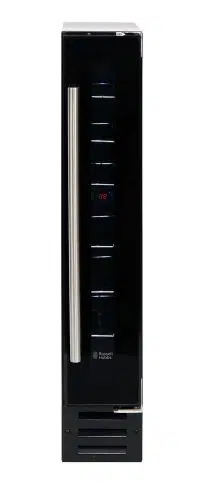Documents: Go to download!
- User Manual - (English)
- Installing and Switching on Your Appliance
- Before Switching On
- Product Overview
- Positioning & Installation
- Handle installation
- Usage
- Door Reversal
- Energy Saving Advice
- Maintenance & Cleaning
- Trouble shooting
- Connection to the Mains Supply
Table of contents
Instruction Manual Wine Cooler
Installing and Switching on Your Appliance
- Operating voltage for your appliance is 220-240V at 50Hz.
- Before plugging in the power supply, ensure that the voltage on the rating label correspondsto the working voltage of your electricalsystem in your home.
- Insert the plug into an efficient Ground (Earth) connection. If the socket has no Ground (Earth) contact or the plug does not match, we suggest you call an authorised electrician for assistance.
- Place your appliance in an area that is not exposed to direct sunlight.
- Your appliance should be placed at least 10cm away from stoves, ovens and other heating cores.
- This appliance should never be used outdoors or left in the rain.
- When your appliance is placed next to a chest freezer or freezer, there should be at least 10cms between them to prevent humidity on the outer surface.
- Do not place anything on your appliance and install the unit in a suitable place so that there is at least 30cm clearance above the appliance.
- If placing your appliance next to kitchen cabinets, leave 5cm between them.
- The rear of the appliance should be at least 6cm away from the back wall.
- The appliance must be used in the vertical position and on a flat surface.
- To level the appliance, use the adjustable feet on the appliance.
- Do not place your appliance on a carpeted surface as this will prevent adequate ventilation.
- This appliance should only be placed on a flat, firm surface.
- Choose a dry and well-ventilated space.
- The appliance should be positioned so that the plug is easily accessible.
- If you need help or are unsure how to install the unit, please contact Customer Services
WARNING! During using, service and disposal the appliance, pease pay attention to symbol similar to one shown, which is located on rear of appliance (rear panel or compressor) and with a yellow or orange colour. It’s risk of fire warning symbol. There are flammable materials in refrigerant pipes and compressor. Please be far away fire source during using, service and disposal.
Before Switching On
- Before using your appliance, add a teaspoon of bicarbonate of soda to warm water and with a damp cloth wipe down all parts of the new appliance, then repeat the process with a clean damp cloth and dry (ensure the appliance is not connected to the power when performing this task).
- Remove all transport tapes and foam protection pieces. Clean the interior with a cloth dampened in lukewarm soap and water. Wipe with clean water and wipe dry.
- There may be an odour when you first switch on the appliance, it will disappear when the appliance starts to cool.
- When the appliance has been positioned, adjust the feet to ensure the unit is stable. This is essential to ensure quiet running and proper door opening /closing.
- Connect to the electrical socket but do not switch the power to the cooler on for at least 3 hours. The coolant within the product needs time to settle after it has been transported and put in to position, failure to do this will affect the cooling performance of your appliance.
- Once the appliance has settled turn on the appliance, locate the temperature controls on the product and set it to the required temperature.
- You may hear faint gurgling or bubbling sounds when the refrigerant is pumped to the cooling system and through the coils or tubing at the rear of the appliance. When the compressor is in operation you may hear a slight whirring sound or pulsating noise. The temperature controls regulate the operation of the compressor, and you may hear a slight click as it cycles in and out (this is normal).
- To save energy, you should minimize the frequency and duration of door opening
Product Overview
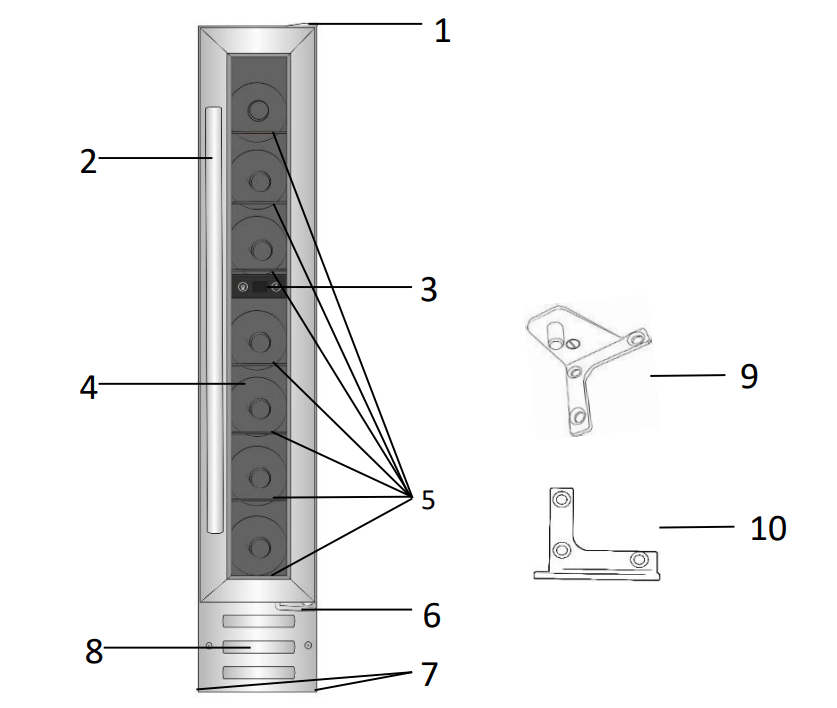
- Upper hinge
- Handle
- Controls & display
- Glass door
- Bottle racks
- Lower hinge
- Adjustable feet
- Vents
- Door reversal left top hinge
- Door reversal left bottom hinge
Positioning & Installation
- This appliance can be installed as a freestanding or a built in unit. The clearances shown in the below drawing should be followed for both types of installation.
- Avoid damaging the product during installation, positioning of the appliance requires two people in order to avoid injuries or damage to the appliance.
- Your appliance should not be located in direct sunlight or exposed to continuous heat or extremes of temperature (e.g. next to a radiator or boiler). If this is not feasible, then you should install an insulation plate between the appliance and the adjacent heat source.
- You should check whether there is an electrical socket available, which will be accessible after your appliance is installed.
- Place the appliance flatly and firmly on a solid base. The appliance is fitted with adjustable feet, which should be used to level the appliance.
- Be sure to leave enough space for the opening of the door, to avoid damage to the appliance or personal injury
- If installing as a built in unit the aperture size has to be a minimum of (H)875 x (W)155 x (D)570mm. The depth dimensions in particular must be observed.
Important: The vent at the base of the appliance is for ventilation. Nothing should be placed in front of this vent; otherwise your wine cabinet may not operate properly.
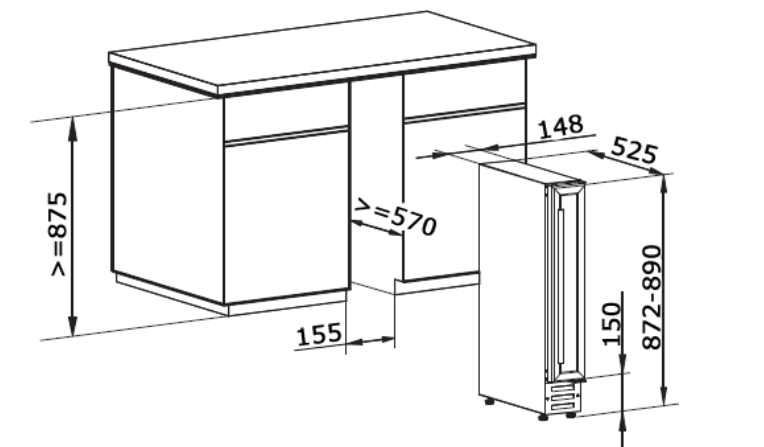
- A decorative plinth can be fitted to the front of the base vent as long as the cut out shown in the diagram below is made in the plinth. This cut out is required whether the vent is removed or not

Handle installation
To install the door handle follow the below steps:
- Open the door of the appliance and move the door gasket slightly to one side so that you can see two designated holes for handle installation
- Install the handle tightly as shown in the diagram above with the two screws provided.
- Ensure the door gasket falls back into place and that the door opens and closes correctly.
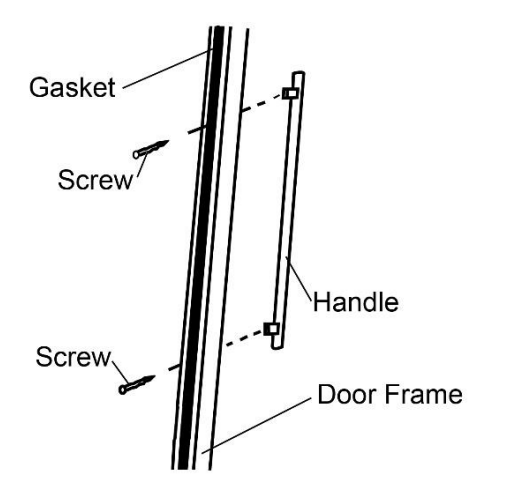
Usage
Control panel
The control panel is situated in the middle of the appliances cavity and has a power, light, temperature up and temperature down touch controls, these are explained below:
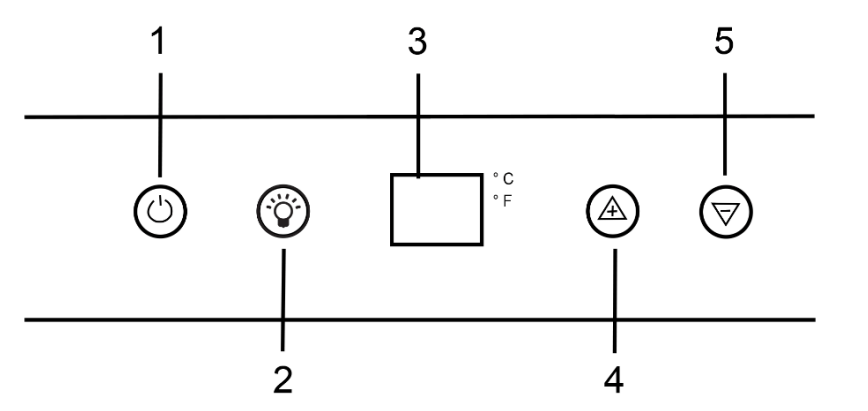
- Power on/off – press to turn the appliance on and off
- Light on/off – press to turn the internal light of the appliance on and off
- Temperature display – displays the internal temperature of the appliance in Celsius or Fahrenheit
- Temperature up – press to increase the internal temperature of the appliance
- Temperature down – press to decrease the internal temperature of the appliance
Allow to stand for a minimum of 3 hours before plugging in to the mains
During first use
- Important: When you use the wine cooler for the first time or restart the appliance after it has been turned off for a long time, there could be a few degrees variance between the temperature you select and the one indicated on the display. This is normal and it is due to the length of activation time. Once the wine cabinet has been running for a few hours everything will be back to normal.
- When you first switch on the appliance, the compressor will run continuously until the wine cabinet reaches a cool enough temperature. During this period of time, you should try not to open the door frequently or place bottles inside of the appliance.
- If the unit is switched off or unplugged, you must allow at least 5 minutes before restarting the appliance or reconnecting it to your mains supply.
Switching on the appliance and setting the temperature
Follow the below steps to switch on the appliance and set the required temperature:
- Switch the appliance on at the plug, then press and hold the power on/off control button for at least 5 seconds. The appliance will beep and the internal temperature of the appliance will be shown on the display.
- The temperature setting for the appliance is adjustable within the range of 5°C to 22°C or 40°F / 72°F.
- When you press the temperature up or temperature down controls for the first time, the LED display will show the factory default temperature setting of 12°C / 54°F.
- Use the temperature up and temperature down controls to set the desired internal temperature.
- The temperature will increase by 1°C or 1°F if you touch the temperature up control once and will decrease by the same amount if you press the temperature down control once.
- When you set a new temperature, the display will show the previous temperature for 5 seconds, before showing the actual temperature. During this time, the cooler temperature will adjust accordingly.
- To view the set temperature in the wine cooler, press the temperature up or temperature down control. The display will flash the temperature for 5 seconds.
Note: We recommend that the door is not opened for a minimum of 4 hours to allow the appliance to reach the standard operating temperature.
Note: The temperature of the drinks and how often the door is opened affects the temperature in the cooler. If required, change the temperature setting.
Note: Cool air falls and warmer air rises, so there will be a slight temperature variation between the top of the cabinet and the bottom of the cabinet.
Important: When the temperature is changed, the compressor works harder to reach the required temperature. During this time, the side panels of the wine cabinet can reach up to 45°C however they will cool down when the set temperature is reached.
Changing between Fahrenheit and Celsius
You can select whether the temperature display shows Celsius or Fahrenheit:
- To change the temperature reading from Celsius to Fahrenheit you must press and hold the light on/off control until the appliance beeps and the °F indicator is lit.
- You cannot change the display if you are in the process of adjusting the temperature of the wine cabinet.
Loading the wine cooler
Important: Your appliance is ideally suited to store 0.75 litre Bordeaux style wine bottles. While the cabinet can store larger bottles, you must make sure that they do not prevent the door from shutting properly.
- Always check that you can close the door without it touching on a wine bottle, before shutting it.
- When loading several bottles of wine at once, it will take longer for the appliance to cool the individual bottles.
- As many bottles may differ in size and dimensions, the actual number of bottles you are able to store may vary. The maximum storage number is based on standard 0.75 litre Bordeaux style wine bottles.
- You can place 7 standard size bottles in your appliance with 1 bottle on each shelf.
Storing your wines
The chart below indicates the ideal storage temperatures for different types of wine:-
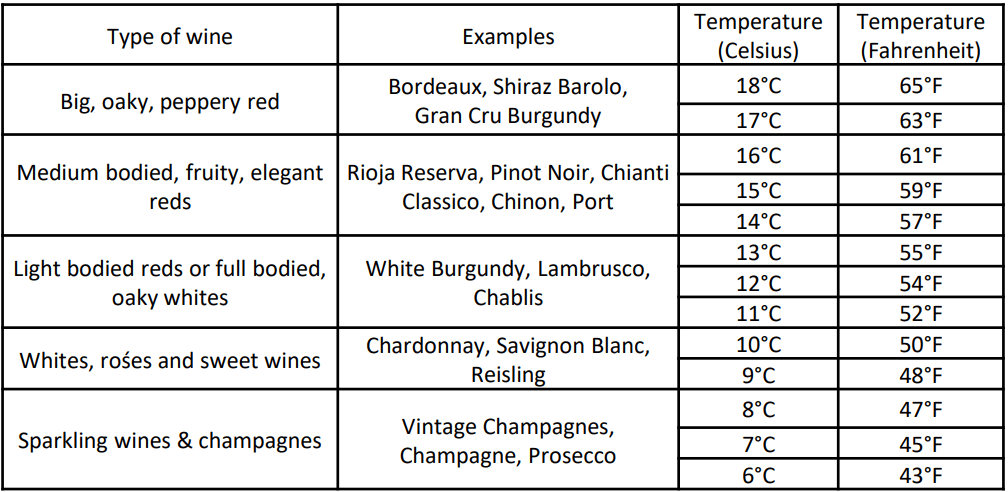
- Temperature stability is the most important factor when it comes to storing wine.
- Exposure to light, vibrations or fluctuations in temperature and humidity can all cause wine to spoil. When properly stored, wines not only maintain their quality but many will actually improve in aroma, flavour and complexity as they mature.
- Wines kept at a higher temperature will age faster. Wine that is exposed to temperatures that are greater than 21°C (70°F) will suffer from poorer flavour and aroma.
- If wine is kept at too low a temperature, this can result in the development of harmful deposits. A humidity of 70% is ideal for keeping corks from shrinking.
- After a bottle of wine has been opened, the wine comes into contact with air. So it is best to store the remainder of the bottle upright, to minimize the surface area of the wine that is coming into contact with the air.
- Once opened, wine will remain in a drinkable condition for two days for delicate whites or three days for rich reds, as long as the bottle has been resealed. You should make sure that the seal is firm by checking the stopper.
- Special stoppers that keep wine sparkling and Champagne bubbling for one or two days after opening, can be bought.
- When stored correctly, unopened white wines can keep well for up to two years. Full bodied reds (unopened) will age well for ten years and dessert wines (unopened) will age well for up to twenty years.
- When you buy a bottle of wine, you should transfer it to a suitable storage location immediately (if you are not going to store it in your wine cooler).
- Cheaper bottles of wine will not age as well as more expensive ones.
- To make the most of the bouquet and taste of your wine, never fill more than half a glass at a time. It will also help if the shape of your wine glass is appropriate for your wine. The size and shape of your wine glass’s bowl will determine the intensity and complexity of the bouquet. The stem should be long enough to allow you to avoid hand contact with the bowl of the glass and should be tulip-shaped or tapered at the top.
Wine storage problems
- Corking - a tiny percentage of bottled wine (about 1%) will suffer from this. The cork reacts with the wine and gives it a musty, unpleasant taste. It is the most common wine storage problem and is caused by harmless bacteria growing on the cork. As unfortunate as this is, there is nothing to do but to discard all of the wine in the affected bottle. This is not to be confused with small fragments of cork floating in the wine itself, which will not impair the flavour.
- Oxidisation - when wine has been opened and left for longer than a day; it tends to lose its aroma and colour, giving an overall flat taste. The only way to avoid this, it to either drink the wine on the same day it was opened or to use a vacuum device specially designed for removing oxygen from opened wine bottles. If you use such a device, the wine should still be consumed shortly afterwards.
- Ullage - this is loss of wine from the bottle by evaporation or leakage. Signs of ullage include wine seeping around the cork, a protruding cork or a stained label. It can happen if the bottle has been allowed to get too warm. The wine may still be drinkable, if the leakage was recent; however, you should be aware that if the wine cools down again, contraction can cause more air to be sucked into the bottle and result in further deterioration.
- Slight effervescence in still wine - this isn’t really a problem with the way the wine has been stored, but as a result of incomplete malolactic fermentation before the wine was bottled. A good way to get rid of the effervescence is to let the wine breathe. Alternatively you can use a bottle vacuum device, after about five minutes the effervescence will vanish.
- Sediment - this is not normally a problem, however both red and white wines can produce sediment after a number of months in a bottle. The sediment consists of tartrate crystals and is totally harmless. If anything the building of sediment can be considered a good sign because it means that the wine was not subjected to much (if any) filtering, meaning that the flavours and aromas should be preserved better.
- A good way to get around sediment (if it is a problem) is to stand the bottle upright, the day before opening, so that the sediment can settle to the bottom of the bottle.
- You can also decant your wine; decanting will “open up” the flavour of both young and old wines, but younger wines in particular. To decant, pour the wine slowly and evenly into your decanter.
Door Reversal
This appliance has the capability of the door opening from either the left or right hand side.
Any parts that you remove from the appliance whilst reversing the door, should be retained for later use.
You will need to tilt the cooler backward to access the lower hinge which holds screws. Do not tilt more than 45 degrees and do not lay the cooler flat on its side.
Reversing the door:
- Open the glass door and remove the two screws under the bottom hinge. These are used to hold the right lower hinge to the door shaft assembly.
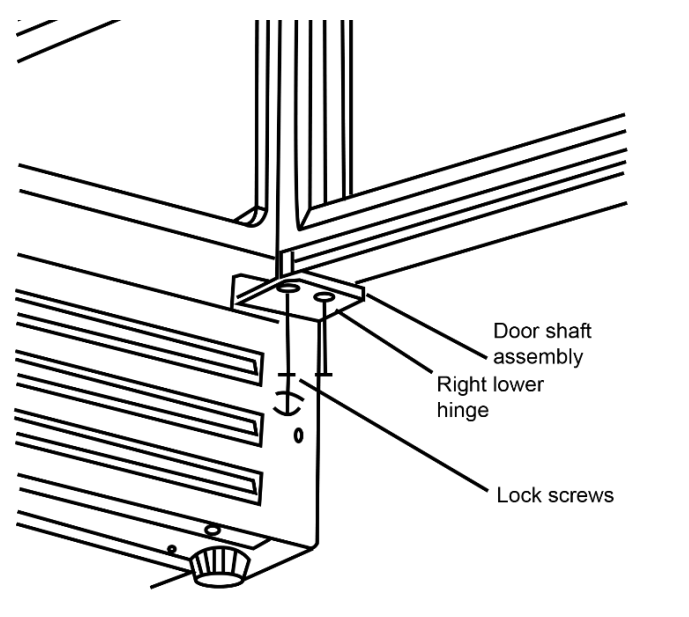
2. Be careful to support the glass door with both hands to prevent it dropping after removing the screws. Pull down to remove the glass door and place it on a padded surface to prevent scratching it.
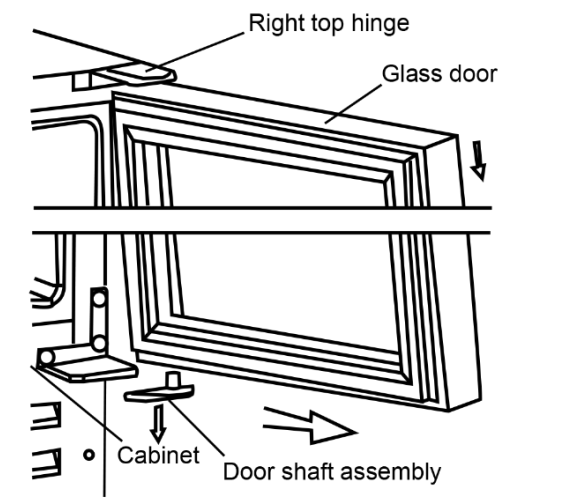
3. Remove the 3 screws from the right top hinge and right lower hinge.
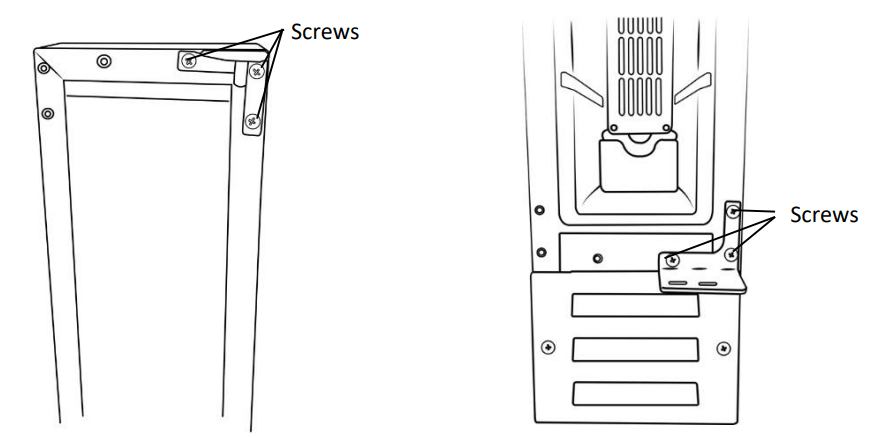
4. Remove the plastic screw covers from the bottom left and top left of the appliance.
5. Take the left top hinge and left bottom hinge from the plastic bag that contained the instructional manual then install them in the designated positions on the left side of the cabinet
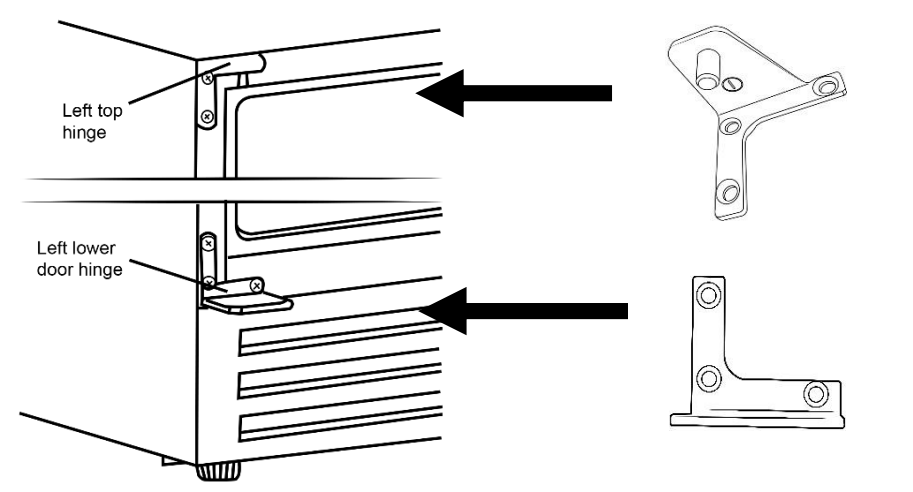
6. Turn the glass door around 180°, put the door shaft assembly from step 1 into the hole on the bottom of the door and reinstall it. Fix the 2 screws into the bottom hinge and the door shaft assembly
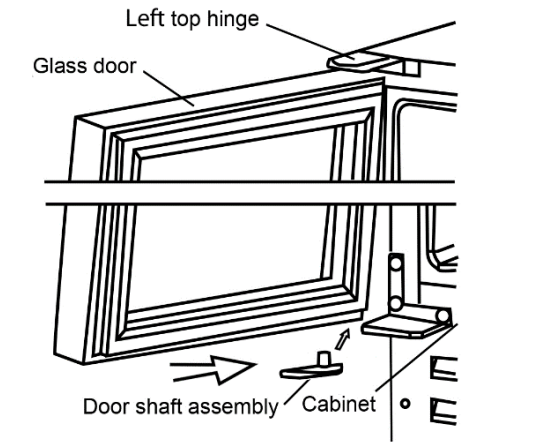
7. Replace the plastic screw covers from step 4 on the holes on the right hand side.
Check that the door opens and shuts correctly after you have completed the door reversal process.
The appliance must now be upright for a minimum of 3 hours before turning it on.
Energy Saving Advice
- Do not install the appliance close to sources of heat, such as a cooker, dishwasher or radiator.
- Locate the appliance in a cool well-ventilated room and make sure that the air vents are clear.
- Try to avoid keeping the doors open for a long time, warm air will enter the cabinet and may cause a build-up of ice as well as affecting the energy consumption. Ensure there are no obstructions preventing the doors from closing properly.
- Ensure that the door seals are clean and there are no tears or splits.
- Do not overload the appliance; the cooling air that circulates to keep the appliance cold gets blocked and pockets of warm air form.
Maintenance & Cleaning
Disconnect the appliance from the power supply before cleaning.
Internal Cleaning
- Do not pour water over the appliance.
- The cavity should be cleaned periodically using a solution of bicarbonate of soda and lukewarm water (5ml to 0.5 litre of water)
- Clean the accessories separately with soap and water. Do not put them in the dishwasher.
- Do not use abrasive products, detergents or soaps.
- After washing, rinse with clean water and dry carefully.
- When you have finished cleaning reconnect the plug with dry hands.
External Cleaning
- Wash the outer cabinet with warm soapy water. Do NOT use abrasive products.
- There are sharp edges on the underside of the product so care should be taken when cleaning.
- Once or twice a year dust the rear of the appliance and the compressor at the back of the appliance, with a brush or vacuum cleaner, as an accumulation of dust will affect the performance of the appliance and cause increased energy consumption
When the appliance is not in use
- When the appliance is not in use for long periods, disconnect from the electricity supply, empty all of the food and clean the inside. Leave the door open to prevent the build-up of odours.
Defrosting
- Defrosting occurs automatically inside of the wine cabinet during operation. The defrost water is collected by the evaporating tray and evaporates automatically.
- The evaporating tray and defrost water drain hole should be cleaned periodically. This will prevent water from collecting in the bottom of the wine cabinet, instead of flowing down the defrost drainage channel and drain hole.
- You can also pour a small amount of water down the drain hole to clean inside of it.
- You should be careful to make sure that wine bottles do not touch the rear wall of the appliance, as this can interrupt the automatic defrosting process and deflect water into the base of your wine cabinet.
Trouble shooting
Problem | Solution |
The cooler doesn't work | Check that the appliance is switched on. |
Check that there has not been a power cut. | |
Check that the plug is not faulty. | |
Check that the fuse has not blown. | |
Check that the voltage is correct for the appliance. | |
Are there any faults with the socket? For this purpose, try the plug of your appliance by connecting it to a socket which you are sure is working. | |
Temperature inside the appliance is too warm. | The temperature controls are set too warm. Set the temperature controls to a cooler setting and allow several hours for the temperature to stabilise. |
The door is being kept open too long or is being opened too frequently, which is allowing warm air to enter the appliance. | |
The door is not closed completely. | |
The door gasket is not sealing correctly. | |
| The appliance has recently been disconnected from the mains supply; it will take at least four hours for it to get down to temperature again. | |
Temperature inside the appliance is too cold | The temperature controls are set too cold. Set the temperature controls to a warmer setting and allow several hours for the temperature to stabilise. |
Vibration | Check to ensure that the appliance is on a level surface. |
The appliance is touching the back wall behind it. Reposition the appliance and move it from the wall. | |
If vibration continues to occur, then turn off the appliance and unplug it from your mains supply. Then contact the Customer Care Department for assistance. | |
Moisture is forming on the inside of the appliance. | The door is slightly open, causing cold air from inside the appliance to meet warm, moist air from the outside. |
The door is being kept open too long or is being opened too frequently. Open the door less often. | |
The door is not sealed properly. | |
The inner surfaces of the appliance are wet | Caused by condensation - dry the inside of the appliance. |
The outer surfaces of the appliance are wet | Caused by condensation - dry the outer of the appliance carefully. |
Smell/odour | Check all the drink that is in the cooler is in date and correctly packaged. If it isn’t then it should be removed immediately or repackaged. |
Check for spillages on each shelf and rack. Spillages that have not been cleaned and have been left can cause smells and unwanted odours. | |
The doors do not close properly | Ensure there are no obstructions preventing door closure. |
Check the door compartments and shelves are correctly in place. | |
Check the door seal is not warped or torn. | |
Check the appliance is level. | |
Moisture is forming on the inside of the appliance. | The door is slightly open. |
Unusual noises | Check that the appliance is on a flat, level surface and is stable. |
Check the spacing's around the appliance and ensure it is not touching other items. | |
Bubbling and gurgling sound: This noise is emitted as the coolant fluid flows through the pipes within the system. This is normal. | |
Water flowing sound: This is the normal sound of water flowing into the drain trough during the defrosting process. | |
If the appliance is operating noisily (compressor noise): This is normal. This noise indicates that the compressor is operating normally. As the compressor is being energized, it might run a bit more noisily for a short period of time. |
Connection to the Mains Supply
WARNING- THIS APPLIANCE MUST BE EARTHED
- This appliance is designed to operate from a mains supply of AC220V - 240V; 50HZ. Check that the voltage marked on the product corresponds with your supply voltage.
- For UK use only – Plug fitting details (where applicable): As the colours of the wires in the mains lead of this appliance may not correspond with the coloured markings identifying the terminals in your plug, proceed as follows:
- The GREEN/YELLOW wire is the EARTH and must be connected to the terminal which is marked with the letter E or by the earth symbol or coloured GREEN or GREEN/YELLOW.
- The BLUE wire is the NEUTRAL and must be connected to the terminal marked with the letter N or coloured BLACK.
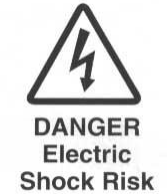
- The BROWN wire is the LIVE wire and must be connected to the terminal marked with the letter L or coloured RED.
- Always ensure that the plug cord grip is fastened correctly.
- If a 13A (BS1363) fused plug is used it must be fitted with a 13amp fuse conforming to BS1362 and be BSI or ASTA approved.
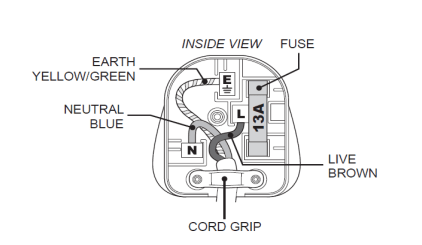
See other models: RHM2079A 22407 24420 24320 RHSCH601B
